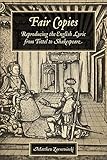Fair Copies : Reproducing the English Lyric from Tottel to Shakespeare / Matthew Zarnowiecki.
Material type: TextPublisher: Toronto : University of Toronto Press, [2014]Copyright date: ©2014Description: 1 online resource (248 p.) : 15 b&w illustrations, 1 b&w tableContent type:
TextPublisher: Toronto : University of Toronto Press, [2014]Copyright date: ©2014Description: 1 online resource (248 p.) : 15 b&w illustrations, 1 b&w tableContent type: - 9781442647183
- 9781442667471
- 821/.040903 23/eng/20230216
- online - DeGruyter
| Item type | Current library | Call number | URL | Status | Notes | Barcode | |
|---|---|---|---|---|---|---|---|
 eBook
eBook
|
Biblioteca "Angelicum" Pont. Univ. S.Tommaso d'Aquino Nuvola online | online - DeGruyter (Browse shelf(Opens below)) | Online access | Not for loan (Accesso limitato) | Accesso per gli utenti autorizzati / Access for authorized users | (dgr)9781442667471 |
Frontmatter -- Contents -- Illustrations -- Acknowledgments -- A Note on the Text -- Introduction -- 1. The “vnquiet state” of the Lover: Richard Tottel’s Lyric and Legal Reproductions -- 2. “Nedelesse Singularitie”: George Gascoigne’s Strategies for Preserving Lyric Delight -- 3. Solitude, Poetic Community, and Lyric Recording in Spenser’s Shepheardes Calender and Colin Clovts Come home againe -- 4. Lyric Surrogacy: Reproducing the “I” in Sidney’s Arcadia -- 5. “All Men Make Faults”: Begetting Error in Shake-speares Sonnets -- Coda: The End of Shake-speares Sonnets -- Notes -- Works Cited -- Index
restricted access online access with authorization star
http://purl.org/coar/access_right/c_16ec
In the latter half of the sixteenth century, English poets and printers experimented widely with a new literary format, the printed collection of lyric poetry. They not only investigated the possibilities of working with a new medium, but also wrote metaphors of human reproduction directly into their works. In Fair Copies, Matthew Zarnowiecki argues that poetic production was re-envisioned during this period, which was rife with models of copying and imitation, to include reproduction as one of its inherent attributes.Tracing the development of the English lyric during this crucial period, Fair Copies incorporates a diverse range of cultural productions and reproductions – from key poetic texts by Shakespeare, Sidney, Spenser, Gascoigne, and Tottel to legal breviaries, visual representations of song, midwives’ manuals, and commonplace books. Also included are fifteen facsimile reproductions of poems in early printed books, with explanations and discussions of their importance. Calling upon these diverse sources, and examining lyric poems in their earliest manuscript and printed contexts, Zarnowiecki develops a new, reproductively centred method of reading early modern English lyric poetry.
Mode of access: Internet via World Wide Web.
In English.
Description based on online resource; title from PDF title page (publisher's Web site, viewed 01. Dez 2023)


